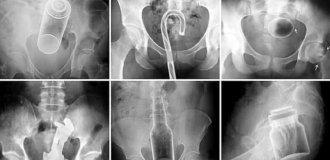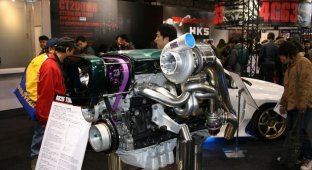Design and principle of operation of an internal combustion engine (18 photos + 3 videos)
In order to understand the principle of operation of an engine, you need to have some understanding of the engine itself and its structure. Let's look at everything in more detail:

In an engine design, the piston is a key element of the working process. The piston is made in the form of a metal hollow glass, located with a spherical bottom (piston head) upwards. The guide part of the piston, otherwise called the skirt, has shallow grooves designed to hold the piston rings in them. The purpose of the piston rings is to ensure, firstly, the tightness of the space above the piston, where during engine operation instantaneous combustion of the gasoline-air mixture occurs and the resulting expanding gas could not go around the skirt and rush under the piston. Secondly, the rings prevent oil located under the piston from entering the space above the piston. Thus, the rings in the piston act as seals. The lower (lower) piston ring is called the oil scraper ring, and the upper (upper) is called the compression ring, that is, providing a high degree of compression of the mixture.

When a fuel-air or fuel mixture enters the cylinder from a carburetor or injector, it is compressed by the piston as it moves upward and ignited by an electric discharge from the spark plug (in a diesel engine, the mixture self-ignites due to sudden compression). The resulting combustion gases have a significantly larger volume than the original fuel mixture, and, expanding, sharply push the piston down. Thus, the thermal energy of the fuel is converted into reciprocating (up and down) movement of the piston in the cylinder.

Next, you need to convert this movement into shaft rotation. This happens as follows: inside the piston skirt there is a pin on which the upper part of the connecting rod is fixed, the latter is pivotally fixed to the crankshaft crank. The crankshaft rotates freely on support bearings located in the crankcase of the internal combustion engine. When the piston moves, the connecting rod begins to rotate the crankshaft, from which torque is transmitted to the transmission and then through the gear system to the drive wheels.

Engine Specifications.Engine Characteristics When moving up and down, the piston has two positions called dead centers. Top dead center (TDC) is the moment of maximum lift of the head and the entire piston up, after which it begins to move down; bottom dead center (BDC) is the lowest position of the piston, after which the direction vector changes and the piston rushes upward. The distance between TDC and BDC is called the piston stroke, the volume of the upper part of the cylinder when the piston is at TDC forms the combustion chamber, and the maximum volume of the cylinder when the piston is at BDC is usually called the total volume of the cylinder. The difference between the total volume and the volume of the combustion chamber is called the working volume of the cylinder.
The total working volume of all cylinders of an internal combustion engine is indicated in the technical characteristics of the engine, expressed in liters, and therefore is commonly referred to as engine displacement. The second most important characteristic of any internal combustion engine is the compression ratio (CR), defined as the quotient of the total volume divided by the volume of the combustion chamber. For carburetor engines, CC varies from 6 to 14, for diesel engines - from 16 to 30. It is this indicator, along with engine volume, that determines its power, efficiency and completeness of combustion of the fuel-air mixture, which affects the toxicity of emissions during internal combustion engine operation. .
Engine power has a binary designation - in horsepower (hp) and in kilowatts (kW). To convert units from one to another, a coefficient of 0.735 is used, that is, 1 hp. = 0.735 kW.
The working cycle of a four-stroke internal combustion engine is determined by two revolutions of the crankshaft - half a revolution per stroke, corresponding to one piston stroke. If the engine is single-cylinder, then unevenness is observed in its operation: a sharp acceleration of the piston stroke during explosive combustion of the mixture and a slowdown as it approaches BDC and beyond. In order to stop this unevenness, a massive flywheel disk with high inertia is installed on the shaft outside the motor housing, due to which the torque of the shaft becomes more stable over time.
Operating principle of an internal combustion engine
A modern car is most often driven by an internal combustion engine. There are a huge variety of such engines. They differ in volume, number of cylinders, power, rotation speed, fuel used (diesel, gasoline and gas internal combustion engines). But, in principle, the structure of the internal combustion engine is similar.
How does the engine work and why is it called a four-stroke internal combustion engine? It’s clear about internal combustion. Fuel burns inside the engine. Why 4 strokes of the engine, what is it? Indeed, there are also two-stroke engines. But they are used extremely rarely on cars.
A four-stroke engine is called because its work can be divided into four equal parts. The piston will pass through the cylinder four times - twice up and twice down. The stroke begins when the piston is at its lowest or highest point. For motorist mechanics, this is called top dead center (TDC) and bottom dead center (BDC).
The first stroke is the intake stroke

The first stroke, also known as the intake stroke, begins at TDC (top dead center). Moving down, the piston sucks the air-fuel mixture into the cylinder. This stroke operates when the intake valve is open. By the way, there are many engines with multiple intake valves. Their number, size, and time spent in the open state can significantly affect engine power. There are engines in which, depending on the pressure on the gas pedal, there is a forced increase in the time the intake valves are open. This is done to increase the amount of fuel drawn in, which, once ignited, increases engine power. The car, in this case, can accelerate much faster.
The second stroke is the compression stroke

The next stroke of the engine is the compression stroke. After the piston has reached the bottom point, it begins to rise, thereby compressing the mixture that entered the cylinder during the intake stroke. The fuel mixture is compressed to the volume of the combustion chamber. What kind of camera is this? The free space between the top of the piston and the top of the cylinder when the piston is at top dead center is called the combustion chamber. The valves are completely closed during this cycle of engine operation. The more tightly they are closed, the better the compression occurs. In this case, the condition of the piston, cylinder, and piston rings is of great importance. If there are large gaps, then good compression will not work, and accordingly, the power of such an engine will be much lower. Compression can be checked with a special device. Based on the compression level, we can draw a conclusion about the degree of engine wear.
The third stroke is the power stroke

The third stroke is the working one, starting at TDC. It is no coincidence that he is called a worker. After all, it is in this beat that the action that makes the car move occurs. At this stroke, the ignition system comes into operation. Why is this system called that? Yes, because it is responsible for igniting the fuel mixture compressed in the cylinder in the combustion chamber. It works very simply - the system spark plug gives a spark. In fairness, it is worth noting that the spark is produced at the spark plug a few degrees before the piston reaches the top point. These degrees, in a modern engine, are regulated automatically by the “brains” of the car.
After the fuel ignites, an explosion occurs - it sharply increases in volume, forcing the piston to move down. The valves in this stroke of the engine, as in the previous one, are in a closed state.
The fourth stroke is the release stroke

The fourth stroke of the engine, the last one is exhaust. Having reached the bottom point, after the power stroke, the exhaust valve in the engine begins to open. There can be several such valves, like intake valves. Moving upward, the piston removes exhaust gases from the cylinder through this valve - ventilates it. The degree of compression in the cylinders, the complete removal of exhaust gases and the required amount of the intake fuel-air mixture depend on the precise operation of the valves.
After the fourth beat, it’s the turn of the first. The process is repeated cyclically. And due to what does the rotation occur - the work of the internal combustion engine during all 4 strokes, what causes the piston to rise and fall during the compression, exhaust and intake strokes? The fact is that not all the energy received in the working stroke is directed to the movement of the car. Part of the energy goes to spin the flywheel. And he, under the influence of inertia, rotates the engine crankshaft, moving the piston during the period of “non-working” strokes.
Gas distribution mechanism

The gas distribution mechanism (GRM) is designed for fuel injection and exhaust gas release in internal combustion engines. The gas distribution mechanism itself is divided into lower valve, when the camshaft is located in the cylinder block, and overhead valve. The overhead valve mechanism means that the camshaft is located in the cylinder head (cylinder head). There are also alternative valve timing mechanisms, such as a sleeve timing system, a desmodromic system and a variable-phase mechanism.
For two-stroke engines, the valve timing mechanism is carried out using inlet and outlet ports in the cylinder. For four-stroke engines, the most common system is overhead valve, which will be discussed below.
Timing device
At the top of the cylinder block there is a cylinder head (cylinder head) with a camshaft, valves, pushers or rocker arms located on it. The camshaft drive pulley is located outside the cylinder head. To prevent engine oil from leaking from under the valve cover, an oil seal is installed on the camshaft journal. The valve cover itself is installed on an oil-gasoline-resistant gasket. The timing belt or chain fits onto the camshaft pulley and is driven by the crankshaft gear. Tension rollers are used to tension the belt, and tension shoes are used for the chain. Typically, the timing belt drives the water pump of the cooling system, the intermediate shaft for the ignition system and the drive of the high-pressure injection pump (for diesel versions).
On the opposite side of the camshaft, a vacuum booster, power steering or a car alternator can be driven by direct transmission or a belt.

The camshaft is an axis with cams machined on it. The cams are located along the shaft so that during rotation, in contact with the valve tappets, they are pressed exactly in accordance with the engine’s power strokes.
There are engines with two camshafts (DOHC) and a large number of valves. As in the first case, the pulleys are driven by a single timing belt and chain. Each camshaft closes one type of intake or exhaust valve.
The valve is pressed by a rocker arm (early versions of engines) or a pusher. There are two types of pushers. The first is pushers, where the gap is adjusted by calibration washers, the second is hydraulic pushers. The hydraulic tappet softens the blow to the valve thanks to the oil contained in it. There is no need to adjust the clearance between the cam and the top of the tappet.
Operating principle of the timing belt
The entire gas distribution process comes down to the synchronous rotation of the crankshaft and camshaft. As well as opening the intake and exhaust valves at a certain location of the pistons.
To accurately position the camshaft relative to the crankshaft, alignment marks are used. Before putting on the timing belt, the marks are aligned and fixed. Then the belt is put on, the pulleys are “released”, after which the belt is tensioned by the tension roller(s).
When the valve is opened by a rocker arm, the following happens: the camshaft “runs” with a cam onto the rocker arm, which presses on the valve; after passing the cam, the valve closes under the action of a spring. The valves in this case are arranged in a v-shape.
If the engine uses pushers, then the camshaft is located directly above the pushers, when rotating, pressing its cams on them. The advantages of such a timing belt are low noise, low price, and maintainability.
In a chain engine, the entire gas distribution process is the same, only when assembling the mechanism, the chain is put on the shaft together with the pulley.
crank mechanism

The crank mechanism (hereinafter abbreviated as CSM) is an engine mechanism. The main purpose of the crankshaft is to convert the reciprocating movements of a cylindrical piston into rotational movements of the crankshaft in an internal combustion engine and vice versa.

KShM device
Piston

The piston has the form of a cylinder made of aluminum alloys. The main function of this part is to convert changes in gas pressure into mechanical work, or vice versa - to increase pressure due to reciprocating motion.
The piston consists of a bottom, head and skirt put together, which perform completely different functions. The piston bottom, which is flat, concave or convex, contains a combustion chamber. The head has cut grooves where the piston rings (compression and oil scraper) are placed. Compression rings prevent gases from blowing into the engine crankcase, and piston oil scraper rings help remove excess oil from the inner walls of the cylinder. There are two bosses in the skirt that provide placement of the piston pin connecting the piston to the connecting rod.
connecting rod

A stamped or forged steel (less commonly titanium) connecting rod has hinged joints. The main role of the connecting rod is to transmit piston force to the crankshaft. The design of the connecting rod assumes the presence of an upper and lower head, as well as a rod with an I-section. The upper head and bosses contain a rotating (“floating”) piston pin, and the lower head is removable, thereby allowing for a close connection with the shaft journal. Modern technology of controlled splitting of the lower head allows for high precision in joining its parts.
Crankshaft

Made of high-strength steel or cast iron, the crankshaft consists of connecting rods and main journals, connected by cheeks and rotating in plain bearings. The cheeks create a counterweight to the connecting rod journals. The main function of the crankshaft is to receive force from the connecting rod and convert it into torque. Inside the cheeks and journals of the shaft there are holes for supplying oil under pressure by the engine lubrication system.
Flywheel

The flywheel is installed at the end of the crankshaft. Today, dual-mass flywheels, which have the form of two elastically connected disks, are widely used. The flywheel ring gear is directly involved in starting the engine through the starter.
Block and cylinder head

The cylinder block and cylinder head are cast from cast iron (less commonly, aluminum alloys). The cylinder block contains cooling jackets, beds for crankshaft and camshaft bearings, as well as mounting points for instruments and components. The cylinder itself acts as a guide for the pistons. The cylinder head contains a combustion chamber, intake and exhaust ports, special threaded holes for spark plugs, bushings and pressed seats. The tightness of the connection between the cylinder block and the head is ensured by the gasket. In addition, the cylinder head is closed with a stamped cover, and between them, as a rule, a gasket made of oil-resistant rubber is installed.
In general, the piston, cylinder liner and connecting rod form the cylinder or cylinder-piston group of the crank mechanism. Modern engines can have up to 16 or more cylinders.






















